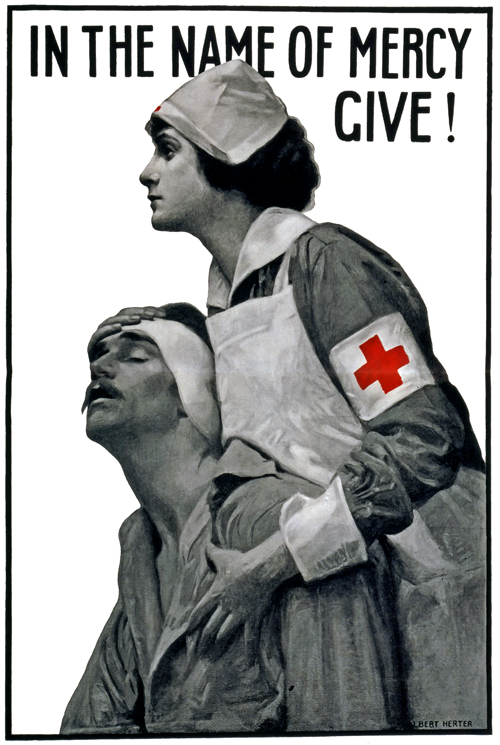
World War I was one of the greatest catastrophes caused by man that history has ever seen. The Axis and Allied forces both dealt with short rations, social upheaval, and millions of deaths, both on and off the battlefield. It’s therefore not surprising that all of the governments involved invested a great deal of effort into encouraging their citizens to aid in the cause, especially through propaganda.
From the beginning to the end of the conflict, a herculean effort was made to increase recruitment for the nursing profession. To encourage women to enter this difficult and dangerous occupation, posters often appealed to the target audience’s patriotism, sense of compassion for soldiers on the front line, and religious values.
To find out more, take a look through our list of vintage nursing recruitment posters from WWI; one of the key ways in which governments drummed up support for the Red Cross.
10. “Help!” Library of Congress, 1914-18
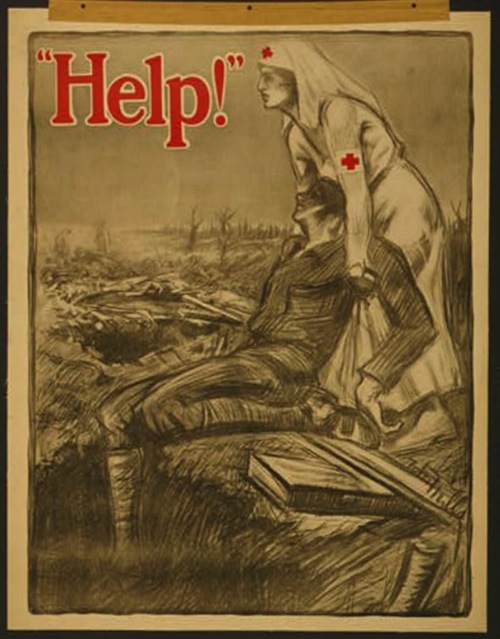
This beautifully drawn poster shows that artistry can be pressed into the service of propaganda. The exact details of when it was created are unavailable, but we can see that it presents a grim view of war. A dying soldier is lying in a nurse’s arms in a muddy and shell-torn field, with other bodies clearly visible in the background.
From its appearance, we might surmise that the poster was created at a time when information about the harsh conditions of trench warfare had filtered back to the civilian world. Instead of shying away from the truth, the poster image presents it in such a way as to appeal to the compassion of the audience. The nurse is depicted as an angelic figure capable of relieving the soldier’s suffering; notice how she is the only bright and clean object in the tableau.
9. “The Greatest Mother in the World.” Alonzo Earl Foringer, 1918
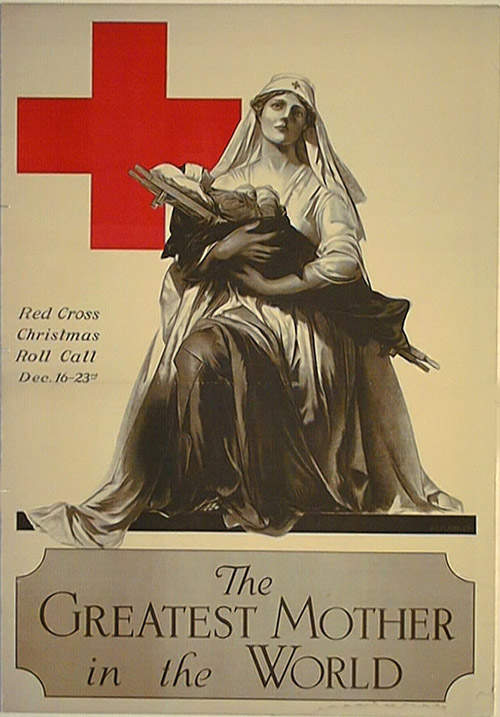
This poster follows a familiar thread in WWI propaganda: appealing to women’s maternal instincts in order to persuade them to contribute to the war effort. We can see the Red Cross represented as a larger-than-life nurse, cradling the body of a badly wounded man in her arms.
With its two figures, the image bears obvious similarities to a traditional Madonna and Child painting. By using this kind of symbolism, the poster is clearly attempting to evoke religious values of love and compassion.
The tag line, “the greatest mother in the world,” would have been very significant. During WWI, many men of marriageable age were conscripted into the army, leaving a lot of women less likely to have the chance to marry or become mothers.
8. “If I Fail, He Dies.” Rev. S.A. Iciek & Arthur G. McCoy, 1918
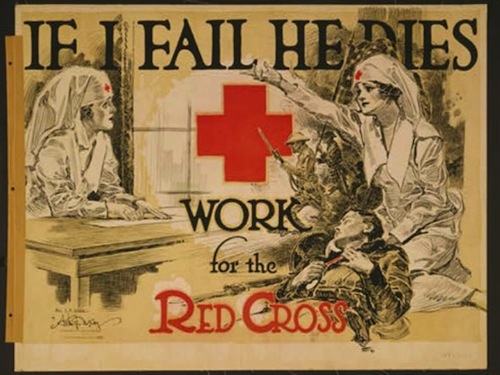
In this poster, we see another maternal nurse figure and a fallen soldier. The soldier is cradled in the protective arms of the woman, under the provocative slogan, “If I fail, he dies.” This emphasis on the romanticized aspects of nursing was also a common theme in the propaganda of this era.
The reality of WWI nursing was bloody, difficult, and sometimes boring. Ellen N. La Motte, one of the first American nurses to be called into action in France in WWI, described the everyday monotony of life: “The same ambulances, and dirty men, and groans, or silence. The same hot operating rooms, the same beds, always full, in the wards. This is war.”
By focusing on the individual heroism of nurses and minimizing the more unpleasant aspects of the profession, this propaganda poster looked to empower women by suggesting that they could help to save soldiers in a way that contributed to the war effort.
7. “America’s Answer to Humanity’s Challenge.” Hayden Hayden, 1917
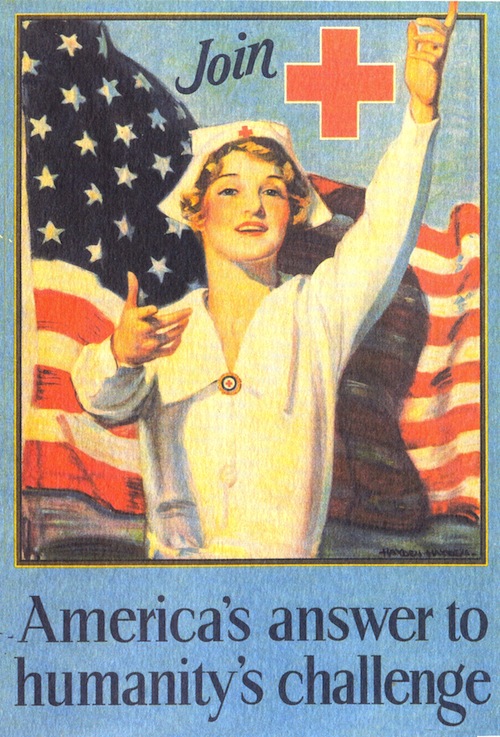
Contrastingly, this poster is brightly colored and positive, which is perhaps the kind of propaganda you might expect to have seen from the US, considering its lower level of war-weariness in 1917 compared to the rest of the Allied nations.
Before 1917, the US had been an isolationist nation, in which public opinion was very much against becoming involved in a European conflict. After the country entered the war, there was a need to drum up public support for internationalism and involvement in Europe.
The tagline, “America’s answer to humanity’s challenge,” appealed to the audience’s particular sense of responsibility and duty, while the prominent American flag in the background was also calculated to elicit a patriotic response.
6. “Motherless, Fatherless, Starving.” Artist unknown, 1917
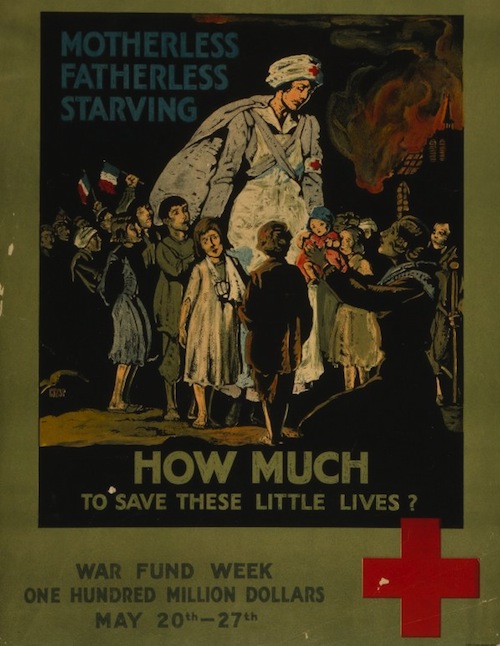
Here’s another poster with a maternal theme, this time depicting a nurse leading a crowd of French children by the hand, with the evocative caption: “Motherless, Fatherless, Starving. How much to save these little lives?” This poster is a more explicitly compassionate “save the children” piece and includes fewer elements that divert from this idea.
The picture is also interesting as wartime propaganda for another reason. Often, posters that focused on other countries used atrocities to generate public outrage against the invader, such as the early propaganda that condemned the German army’s “rape of Belgium.” This advertisement, on the other hand, takes a different tack, depicting the nurse as a heroic figure with a responsibility towards the invaded country and its people.
5. “Help Your Red Cross.” Hubert Chapin, 1917
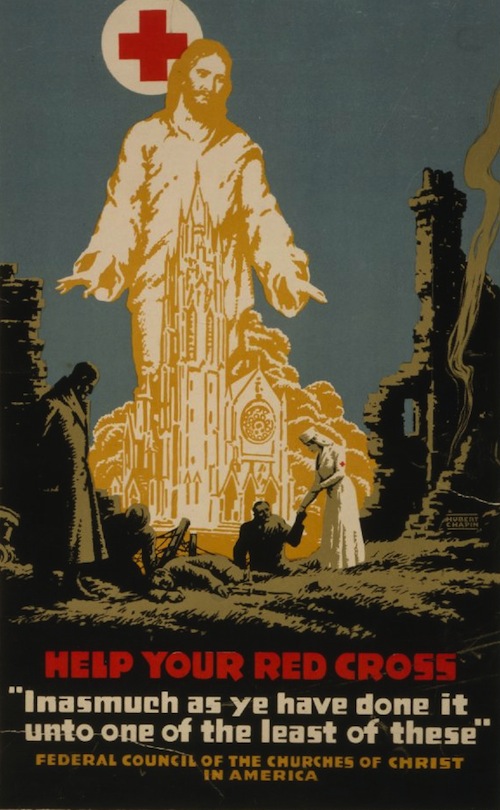
This American poster is another example of explicitly religious propaganda, although in this case it seems to reflect the strong influence of the church on society often noted by observers of the US. The central figure is Jesus, who appears in the clouds, emerging behind the steeple of a church.
In the foreground, a nurse is giving a literal helping hand to an injured soldier, but the female figure is smaller than the male characters in this poster. As a result, this propaganda piece appears much more patriarchal than most of the others in this thread, considering the fact that it is likely to have been aimed largely at female recruits.
Focus is placed on the religious elements in this scene: the Christ-figure in the background and the biblical quotation take up much of the composition. And there is also an effort to appropriate religious authority for the Red Cross, with the Federal Council of the Churches of Christ In America presented as the source of the quotation.
4. “The Red Cross Nurse.” Artist unknown, 1918
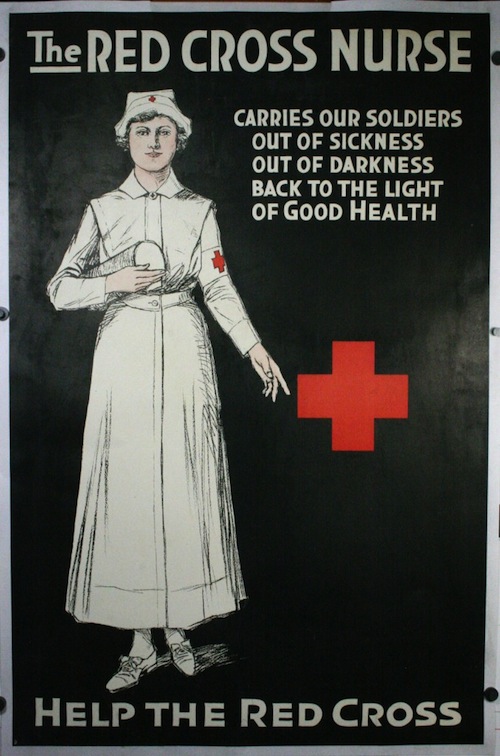
This Red Cross poster explores similar themes to entry 10. As a propaganda piece, it depicts the nurse as a calm figure who can save soldiers no matter how dark their circumstances. However, it presents a more abstract and less explicit view than the first poster, with the “light” and the “darkness” presented more purely as concepts, rather than through the depiction of a muddy, battle-torn field.
The stoical nurse and her spotless uniform imply that entering the medical service brings with it a respectable social position. She is portrayed as an authority figure and someone to aspire to be. This would obviously have been useful when it came to persuading the young women whom this advert was likely targeted towards.
3. “Hold up Your End.” W.B. King, 1917
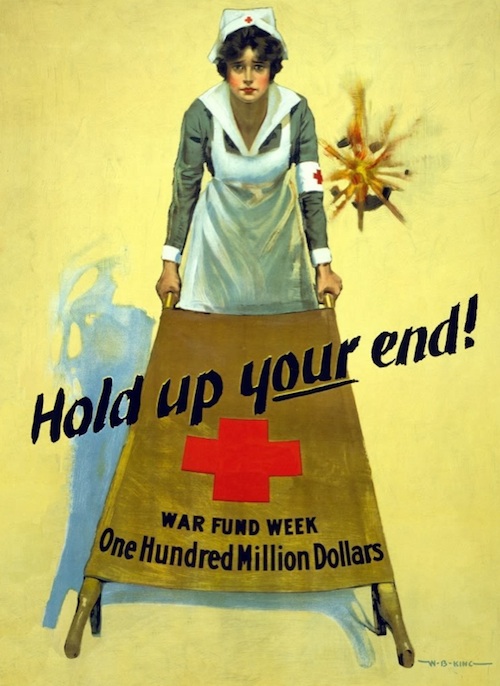
Created in 1917, this poster was part of a drive to raise funds for the Red Cross. It thus represents different values to most nursing recruitment posters. Rather than portraying the nurse as an empowered savior of front-line soldiers, this poster presents her as someone who may be in need of assistance herself.
Metaphorically, the role of the missing stretcher-carrier was clearly meant to be filled by the assistance of the audience. The obvious danger of the situation and the imploring look in the nurse’s eyes were cleverly designed to appeal to the public’s protective instincts.
2. “Help.” David Henry Souter, 1917
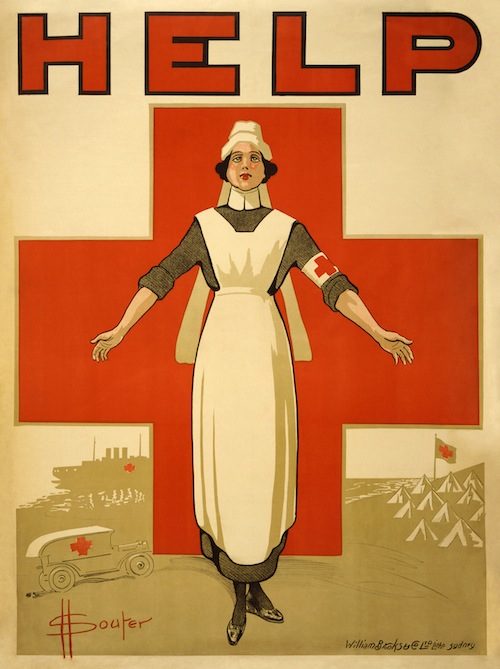
This is another example of a WWI propaganda poster with strong religious imagery. Created by David Henry Souter in Australia in the earliest days of the conflict, it shows a nurse standing in front of the Red Cross symbol in a pose obviously designed to allude to images of the crucifixion.
Despite the fact that the Red Cross symbol was not itself intended to have any religious meaning, in this context it is clearly meant to summon Christian values of self-sacrifice – in keeping with the crucifixion story. The boldness and simplicity of the imagery and the lettering adds to the poster’s powerful impact.
1. “The Comforter.” Gordon Grant, 1918
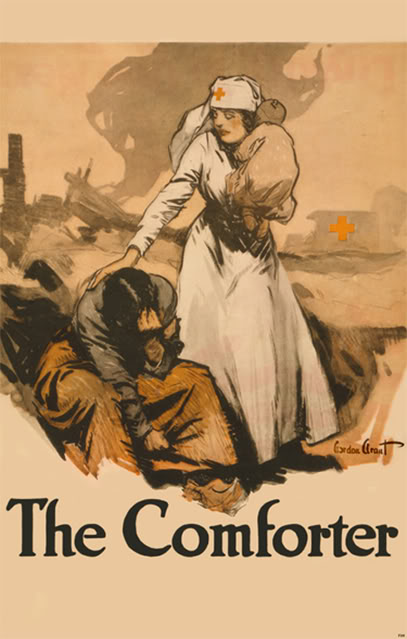
Published in 1918, this is yet another example of a WWI nursing recruitment poster with a maternal theme. The poster was created later in the war, and we can see that the imagery has become more graphic and less abstract, depicting the harsh conditions and other adverse effects of warfare on the Western front.
Looking at the poster, we can see that the nurse and the Red Cross symbol on the ambulance are again presented more clearly than anything else. This reflects the idea of them having been “bright spots” in the chaos of WWI.
The idea of being personally involved with rescuing or comforting soldiers and wounded civilians on the front would no doubt have appealed to many potential nurses at the time. Meanwhile, the decreased prominence of religious imagery compared to the other American posters on this list suits the more “down to earth” visions of war shown in the rest of the picture, as an American Red Cross nurse helps a slumped civilian woman and her young baby.